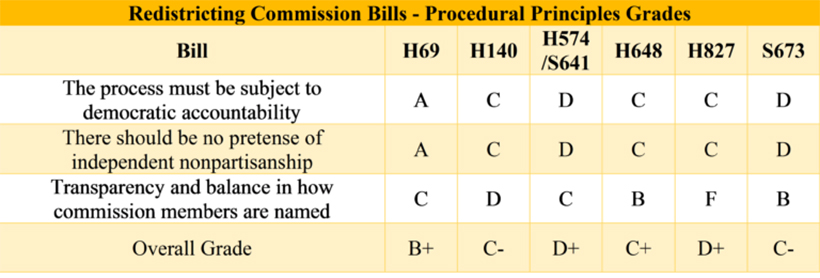Publisher's note: This post, by Andy Jackson, was originally published in Civitas's online edition.
- Most of the six proposed redistricting reform bills do not adhere to procedural principles of redistricting reform
- One bill is stronger than the rest on procedural principles but has a critical flaw
- There are no perfect bills overall. Two are superior to the rest but for different reasons
This is the second of a two-part series critiquing several redistricting reform proposals in the North Carolina General Assembly on their adherence to
principles of redistricting reform. In the
first article, I reviewed the bills based on their adherence to substantive principles. In this article, I give an overview of three procedural principles and then review six bills based on their adherence to those principles.
As in the previous article, I review the following bills:
- H69 (Nonpartisan Redistricting Commission)
- H140 (The FAIR Act)
- H574/S641 (Fix Our Democracy)
- H648 (NC FAIR State & Congressional Districts Act)
- H827 (N.C. Citizens Redistricting Commission)
- S673 (N.C. Citizens Redistricting Commission - same name as H827)
Each principle is briefly summarized below and the six redistricting commission bills are assigned a letter grade that most Americans are familiar with as to how well each adheres to those principles: "A" represents strong adherence to the principle (including in the form of positive amendments to the NC constitution), "B" represents strong statutory adherence to the principle, "C" represents no significant change from current law or an otherwise mediocre adherence to the principle, "D" represents weak adherence to the principle, and "F" represents a complete failure to adhere to the principle (including in the form of negative amendments to the NC constitution).
Principle 1: The process must be subject to democratic accountability. The state legislature has a constitutional role in the redistricting process. That can be accomplished both directly through legislating redistricting bills and indirectly through choosing redistricting commission members. The role of unelected bureaucrats outside the commission should be limited to advising. There should be no special masters (individuals with the power to draw districts by themselves), especially if their maps are not subject to review or revision. The process should be open.
- H69 gives the legislature a strong role in picking commission members and a more limited role in approving the maps drawn by the commission. There is mandated transparency in the process. There is no special master provision. Grade: A
- H140 gives the legislature a strong role in picking commission members and in approving the maps. However, the actual drawing of the maps is done by professional staffers in the General Assembly, which would be reviewed, possibly amended, and approved by the legislature. Grade: C
- Under H574/S641, legislators choose eight commission members, who in turn choose the other seven members. There is mandated transparency in the commission's redistricting process. A special master draws the maps if the commission is deadlocked. That plan would not be subject to review or revision and there is no requirement that the special master draw maps in a transparent process. The General Assembly has no role in approving maps. Grade: D
- H648 gives the legislature a role in selecting most members of the committee. However, the districts are drawn by a special master selected by a simple majority of the committee. There is some mandated transparency. The General Assembly may amend the maps approved by the committee. Grade: C
- Under H827, the legislature and the governor have a role in selecting most members of the committee. The commission must pick a special master to draw the districts if they are deadlocked. There is mandated transparency in the process for the commission, but not for the special master. The General Assembly can reject, but not amend, plans from the commission or the special master. Grade: C
- S673 gives the legislature a role in selecting most members of the committee. A special master draws the maps if the commission is deadlocked. That plan would not be subject to review or revision and would not be made transparently. The General Assembly has no role in approving maps. Grade: D
Principle 2: There should be no pretense of independent nonpartisanship. The pretense of nonpartisanship in the redistricting process invites hypocrisy and makes the process more vulnerable to manipulation. Instead, partisanship should be acknowledged and balanced.
- H69 acknowledges partisanship both in how commission members are chosen and in the need for at least half of each of the partisan groupings (Democrat, Republican, and other) to agree on any final district maps. Grade: A
- In H140, the maps are drawn by professional staffers in the General Assembly's Legislative Services Office. It presumes independent nonpartisanship by those staffers. While that is demonstrably the case, given their working relationships with members of both parties in the General Assembly, we should not have to depend on that assurance. Grade: D
- H574/S641 acknowledges partisanship in how commission members are chosen, in the need for a majority of each partisan grouping to agree to a plan, and in how the special master is selected, but there is no check on the special master after the commission chooses him or her. Grade: C
- In H648 the committee chooses the final map on a simple majority vote. That means that the side that the process is dominated by, whichever side has more of the three "nonpartisan" members voting with it. There is only a minimal check on the special master in the form of the commission being able to choose one of two plans submitted by the special master Grade: C
- How commission members are selected in H827 (see section three below) means that there will not be partisan balance on the commission. However, approval of a plan by the commission and the selection of the special master requires approval by a majority of members of each party affiliation. Grade: C
- S673 acknowledges partisanship in how commission members are chosen. It also requires majorities of each group (Democrats, Republicans, unaffiliated) on the commission to approve of maps. However, there is no check on the special master after the commission chooses him or her. Grade: C
Principle 3: The people chosen to draw maps should acquire their positions in a transparent and balanced process. The process of narrowing the pool of applicants and making the final selection of commission members should be transparent and bipartisan.
- In H69, four legislative leaders (two from each party) have a role in choosing the pool of nominees for the commission. The final list of commission members is chosen by a random method selected by the state auditor. There is a small but real chance (12.5 percent) that all unaffiliated members will come from the nominees chosen by only one party. Grade: C
- H140 gives the legislature a strong bipartisan role in selecting commission members. However, the commission under H140 is only advisory. The actual drawing of the maps is done by unelected professional staffers of the General Assembly's Legislative Services Office. Grade: D
- H574/S641 gives legislators a bipartisan role in selecting commission members but not in choosing the special master. The state auditor vets applicants. Grade: C
- H648 gives legislative leaders a direct role in naming the eight partisan members (two from each major party). Three nonpartisan members are selected by those eight. Grade: B
- Under H827, staffers in the Administrative Office of the Courts would "submit a diverse group of up to 60 applications" to the General Assembly. Each of the two largest parties would pick four commission members and the governor would pick one. Those nine would then select six more members by a simple majority vote. This means that whichever party controls the governor's mansion would have the power to choose 11 of the 15 commission members. Grade: F
- With S673, commission applicants are vetted by the state auditor, based on requirements established by statute, and placed into a pool of qualified applicants. Legislative leaders play a bipartisan role in selecting commission members from that pool. Grade: B
There is only one good bill on procedural principles
All the bills suffer from at least one significant flaw regarding procedural principles, but one bill is clearly less problematic than the others. H69 includes a provision that makes it possible for all unaffiliated commission members to come from a list of nominees provided by one party. However, that bill otherwise strongly accounts for partisanship and gives the legislature a role (even if a diminished one) in the process. All the other bills suffer from numerous flaws that would have to be corrected before the bill should be considered.
Summary of grades for bills on their adherence to procedural principles of redistricting reform.
It should be noted that the problems with H140 are not due to how the commission is constituted, but that the commission only has an advisory role with the actual map drawing done by the Legislative Services Office. Shifting the responsibility of drawing maps from that office to the commission would make H140 the strongest bill on procedural principles.
The final grade: No perfect bills, but two good ones
A review of the six redistricting commission bills reveals that none of them perfectly adhere to the six principles of redistricting reform. Two of them stand above the rest, but for different reasons.
Summary of grades for bills on their adherence to principles of redistricting reform.
While H69 and H140 both have flaws, they point to what a good redistricting reform bill would look like. An ideal bill would have H140's constitutional amendments and most of H69's commission procedures with some rebalancing of how unaffiliated commission members are chosen. Another alternative would be to amend H140 so that the commission constituted in that bill has a more active role in the process.
It seems likely that the General Assembly will pass some kind of redistricting commission bill next year. This examination of the six bills that have been submitted this year shows that two have elements that should be included in a final bill. The General Assembly has what it needs to do redistricting reform right.
























